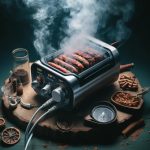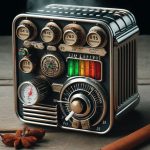Yes, You Can Use Your Smoker in the Winter.
Winter might seem like a challenging time for outdoor cooking, but the answer is a resounding yes—you can definitely use your smoker in the winter. With the right preparation and equipment, you can enjoy delicious, smoky flavors even when the temperatures drop. Here’s what you need to know to keep smoking through the colder months:
- Insulation is Key: Maintaining a consistent temperature inside your smoker is crucial. Use welding or thermal blankets to keep the heat in and your fuel consumption down.
- Fuel Considerations: Opt for lump charcoal over briquettes for a hotter and more efficient burn. Stock up, as you’ll need extra fuel to combat the cold.
- Weather Protection: Ensure your smoker is shielded from snow and rain with a waterproof, breathable cover. This prevents damage and keeps your smoker in good condition.
- Temperature Monitoring: Invest in a digital thermometer to keep a close eye on your smoker’s temperature without lifting the lid and losing heat.
- Experiment with Techniques: Try combining hot and cold smoking or using different woods like hickory or maple to add unique flavors to your winter smoking adventures.
With these tips, winter smoking becomes not just feasible, but a rewarding way to enjoy your favorite meals all year round.
Contents
Winterization
To winterize your smoker for use during colder months, it is essential to consider insulation, fuel, and weather protection.
Using a welding or thermal blanket can help maintain consistent temperatures and conserve fuel. Lump charcoal is recommended for colder weather as it burns hotter and produces less ash.
It is also crucial to protect your smoker with a cover and monitor the temperature closely with a digital thermometer.
Prepare for Winter
When preparing to use a smoker in the winter, follow these important tips to ensure optimal results:
- Use Cold Meat: Cold meat absorbs smoke more effectively than room-temperature meat, resulting in a richer, smokier flavor.
- Start with a Full Load of Charcoal: Light a full load of charcoal in a chimney starter until it just begins to ash over, typically taking about 15 minutes. This ensures a strong, consistent heat source to combat the cold weather.
- Supplement with Wood: Use wood as a supplement to your coals for added flavor. However, be cautious not to use it as the primary fuel source to avoid overwhelming the meat with smoke, creosote, soot, or ash.
- Insulate Your Smoker: Insulating your smoker helps maintain consistent temperatures. Consider using an insulation blanket or welding blanket to wrap your smoker.
- Monitor Temperature Closely: Use a digital thermometer to closely monitor the smoker’s temperature. Winter weather can cause temperature fluctuations, so frequent checks are essential.
- Choose Lump Charcoal: Lump charcoal burns hotter and longer than briquettes, making it ideal for winter smoking.
- Keep the Lid Closed: Resist the temptation to open the smoker’s lid frequently, as this lets out heat and smoke, causing temperature drops.
- Provide Shelter: Position your smoker in a sheltered area away from wind and precipitation. If possible, use a cover to protect the smoker from the elements when not in use.
Maintenance
Properly maintaining your smoker during the winter months is crucial to ensure its longevity and functionality. Here are the key steps you should take:
| Step | Description | Details |
| Choose the Right Spot | Place smoker in a protected area | Shields from wind and cold; stable spot to prevent tipping |
| Secure the Smoker | Anchor to the ground | Prevents movement in strong winds |
| Use a High-Quality Cover | Invest in a weather-resistant cover | Protects from rain, snow, and elements |
| Regular Cleaning and Inspection | Clean and inspect regularly | Remove grease and check for damage or rust |
| Insulation | Use insulation or thermal blanket | Maintains temperature and conserves fuel |
| Monitor Temperature | Keep an eye on the smoker’s temperature | Adjust as needed for consistent cooking |
| Stock Extra Fuel | Have extra fuel on hand | Prepare for unexpected weather delays |
| Protect Electrical Components | Keep electrical parts dry | Use waterproof covers or store indoors |
Add-Ons and Upgrades
In addition to properly maintaining your smoker during the winter, there are also some essential add-ons and upgrades that can greatly enhance your grilling experience. These add-ons and upgrades can help you achieve perfectly smoked meat with delicious flavors, even in the cold winter months.
Flavored Wood Chips
Using high-quality wood chips is a must for any smoker, especially in the winter. Flavored wood chips, such as hickory or applewood, can add a distinct smoky flavor to your meat that is perfect for grilling season. These chips can be easily added to your smoker and will infuse your meat with delicious flavors as it smokes.
Pellet Smoker Tube
A pellet smoker tube is a popular accessory that can take your smoking experience to the next level.
This tube allows you to add extra layers of smoke flavor to your meat by burning pellets inside. It’s a great way to achieve a more intense smoky flavor, especially when using a gas or electric smoker.
Reliable Meat Thermometer

In order to achieve perfectly cooked meat, it’s important to have a reliable meat thermometer. This is especially important in the winter when temperatures can fluctuate and affect the cooking time of your meat.
A good thermometer will ensure that your meat is cooked to the right temperature and will prevent overcooking or undercooking.
High-Quality Rubs and Marinades
While not necessarily an add-on or upgrade for your smoker, using high-quality rubs and marinades can greatly enhance the flavor of your meat. These seasonings can add depth and complexity to your dishes, making them stand out even more in the winter months.
Overall, investing in good quality smoker accessories such as wood chips, thermometers, rubs, marinades, etc. is essential for achieving delicious and flavorful smoked meat even in the colder months.
The Time to Buy
The best time to purchase a smoker for winter grilling is between September and November. This period marks the end of the grilling season, leading to significant discounts as retailers clear out their inventory to make space for new models.
Why September to November is Optimal
Retailers begin to reduce prices after the 4th of July, but the most substantial discounts occur in the fall. During these months, demand for outdoor grilling equipment drops, allowing savvy shoppers to capitalize on lower prices and special promotions.
Benefits of Buying in Fall
- Lower Prices: Retailers offer deep discounts to move inventory.
- Wider Selection: Stores often have a broader range of models available.
- Preparation Time: Purchasing early in the fall gives you time to learn and master your new smoker before the winter season kicks in.
Comparative Analysis
| Month | Price Trend | Selection Availability |
| July – August | Moderate Discounts | High |
| September – November | Deep Discounts | High |
| December – February | Clearance Prices | Limited |
Tips for Finding the Best Deals
- Shop Around: Compare prices at different retailers and online stores.
- Look for Bundles: Some retailers offer bundled deals with accessories.
- Check Reviews: Ensure the smoker meets your needs by reading user reviews.
For additional guidance on choosing the right smoker, you might find this Consumer Reports guide helpful.
Winter is Coming to a Close
As winter comes to a close, it is important to properly use your smoker during the colder months to ensure a successful grilling experience. Here are some tips to keep in mind:
- Choose the right type of wood: When using a smoker, the type of wood used can greatly affect the taste of your food. During the colder months, it is best to use hardwoods such as hickory, oak, or applewood as they burn hotter and longer, making them ideal for colder temperatures.
- Keep an eye on the temperature: In order to properly cook your food, it is crucial to monitor the temperature inside the smoker. During winter, the temperature outside can greatly impact the temperature inside the smoker. To combat this, consider using an insulated smoker or adding a thermal blanket to your existing one.
- Allow for extra cooking time: The cold weather can also affect the cooking time of your food. It may take longer for your food to reach the desired internal temperature, so be sure to plan accordingly and allow for extra cooking time.
- Protect your smoker from the elements: Snow, rain, and wind can all have a negative impact on your smoker and its ability to maintain a consistent temperature. Be sure to protect your smoker with a cover or move it to a sheltered area if possible.
- Experiment with different recipes: Winter grilling is a great opportunity to try out new recipes that are perfect for colder weather. Consider smoking hearty meats like brisket, pork shoulder, or ribs, or even trying out some smoked soups or stews.
Conclusion
Using your smoker in the winter may seem challenging, but with the right preparation and techniques, it’s entirely feasible and can be incredibly rewarding. Ensuring consistent heat is key—wrap your smoker in thermal blankets and use lump charcoal for a hotter, longer burn. Protect your smoker from snow and rain with a waterproof cover and keep a digital thermometer handy to monitor temperatures without losing heat.
Cold weather smoking requires more fuel, so stock up on charcoal and wood, and start with a full load. Insulate your smoker to maintain consistent temperatures, and place it in a sheltered spot to avoid wind and precipitation. Using cold meat enhances smoke absorption, and experimenting with different woods like hickory or maple can add unique flavors.
Proper maintenance is essential: clean your smoker regularly, check for rust, and ensure all parts are secure. Invest in a high-quality cover to protect your smoker from the elements. By following these steps, you can enjoy delicious, smoky flavors all winter long, turning cold weather into an opportunity for culinary adventure.






